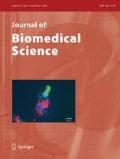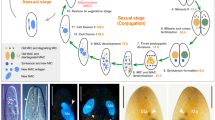Abstract
Tat is one of the regulatory proteins of the HIV-1 virus. To date, besides the transactivation activity, a myriad of effects exerted by HIV-1 Tat on cellular and viral genes have been observed. The present study investigated the in vivo effects of HIV-1 Tat protein in theXenopus embryo. We adopted theXenopus system since expression of putative regulatory factors in the embryo has been widely used as a quick and effective first screen for protein function.Xenopus' early development is well characterized by stage-specific phenotypes, therefore, an in vivo HIV-1 Tat-mediated aberrant phenotype can easily be detected and analyzed. HIV-1 Tat protein expression through injection of synthetic mRNA into zygotes produced a marked delay in gastrulation leading to altered specification of the anterior-posterior axis and to partial or total loss of anterior structures. HIV-1 Tat effects resulted in a general suppression of gene expression, including that ofXbra andgsc, two early genes whose expression is required for proper gastrulation. The specificity of Tat effects was demonstrated by injecting a ‘loss of function’ mutant (Tat-C37S), lacking a single cysteine residue, which did not yield any effect. Both Tat and Tat-C37S were found to be localized mainly in the nucleus. The importance of subcellular targeting for the effects caused by HIV-1 Tat was demonstrated by injecting a second mutant (Tat-BDM), carrying an altered nuclear localization signal sequence. The Tat-BDM protein localized in the cytoplasm and accumulated at the cell membrane. Embryos injected with Tat-BDM mRNA did not develop beyond gastrulation. The importance of proper protein conformation and subcellular localization in determining Tat effects is discussed.
Similar content being viewed by others
References
Almouzni G, Khochbin S, Dimitrov S, Wolffe AP. Histone actylation influences both gene expression and development ofXenopus laevis. Dev Biol 165:654–669;1994.
Almouzni G, Wolffe AP. Replication-coupled chromatin assembly is required for the repression of basal transcription in vivo. Genes Dev 7:2033–2047;1993.
Arya SK, Beaver B, Jagodzinski L, Ensoli B, Kanki PJ, Albert J, Fenyo E, Biberfeld G, Zagury JF, Laure F, Essex M, Norrby E, Wong-Staal F, Gallo RC. New human and simian HIV-related retroviruses possess functional transactivator (tat) gene. Nature 328:548–550;1987.
Arya SK, Guo C, Jospehs SF, Wong-Staal F. Trans-activator gene of human T-lymphotropic virus type III (HTLV-III). Science 229:69–73;1985.
Barillari G, Gendelman R, Gallo RC, Ensoli B. The Tat protein of human immunodeficiency virus type 1, a growth factor for AIDS Kaposi sarcoma and cytokine-activated vascular cells, induces adhesion of the same cell types by using integrin receptors recognizing the RGD amino acid sequence. Proc Natl Acad Sci USA 90:7941–7945;1993.
Battaglia PA, Longo F, Ciotta C, Del Grosso MF, Ambrosini E, Gigliani F. Genetic tests to reveal tat homo-dimer formation and select tat homodimer inhibitor. Biochem Biophys Res Commun 201:701–708;1994.
Battaglia PA, Regoli E, Gigliani F. Measurement of the range of HIV-LTR transcativation activity of HIV in vitro. Int J Oncol 11:1007–1011;1997.
Berkhout B, Silverman RH, Jeang KT. Tat trans-activates the human immunodeficiency virus through a nascent RNA target. Cell 59:273–282;1989.
Beumer TL, Veenstra GJC, Hage WJ, Destrée OHJ. Whole-mount immunohistochemistry on Xenopus embryos using far-red fluorescent dyes. Trends Genet 11:9;1995.
Braddock M, Powell R, Blanchard AD, Kingsman AJ, Kingsman SM. HIV-1 TAR RNA-binding proteins control Tat activation of translation in Xenopus oocytes. FASEB J 7:214–222;1993.
Brown JA, Howcroft TK, Singer DS. HIV Tat protein requirements for transactivation and repression of transcription are separable. AIDS Res Hum Retroviruses 17:9–16;1998.
Buonaguro L, Barillari G, Chang HK, Bohan CA, Kao V, Morgan R, Gallo RC, Ensoli B. Effects of the human immunodeficiency virus type 1 Tat protein on the expression of inflammatory cytokines. J Virol 66:7159–7167;1992.
Buonaguro L, Buonaguro FM, Giraldo G, Ensoli B. The human immunodeficiency virus type 1 Tat protein transactivates tumor necrosis factor beta gene expression through a TAR-like structure. J Virol 68:2677–2682;1994.
Chang HK, Gallo RC, Ensoli B. Regulation of cellular gene expression and function by the human immunodeficiency virus type 1 Tat protein. J Biomed Sci 2:189–202;1995.
Chang HK, Samaniego F, Nair BC, Buonaguro L, Ensoli B. Hiv-1 Tat protein exits from cells via a leaderless secretory pathway and binds to extracellualr matrix-associated heparan sulfate proteoglycans through its basic region. AIDS 11:1421–1431;1997.
Cho KWY, Blumberg B, Steinbeisser H, De Robertis EM. Molecular nature of Spemann's organizer: The role of the Xenopus homeobox gene goosecoid. Cell 67:1111–1120;1991.
Corallini A, Altavilla G, Pozzi L, Bignozzi F, Negrini M, Rimessi P, Gualandi F, Barbanti-Brodano G. Systemic expression of HIV-1 Tat gene in transgenic mice induces endothelial proliferation and tumors of different histotypes. Cancer Res 53:5569–5575;1993.
Cujec TP, Okamoto H, Fujinaga K, Meyer J, Chamberlin H, Morgan DO, Peterlin BM. The HIV transactivator Tat binds to the cdk-activating kinase and activates the phosphorylation of the carboxy-terminal domain of RNA polymerase II. Genes Dev 11:2645–2657;1997.
Destrée OHJ, Bendig MM, Laaf de RTM, Koster JG. Organization of Xenopus histone gene variants within clusters and their transcriptional expression. Biochim Biophys Acta 782:132–141;1984.
Destrée OHJ, Lam KT, Peterson-Maduro LJ, Eizema K, Diller L, Gryka MA, Frebourg T, Shibuya E, Friend SH. Structure and expression of the Xenopus retinoblastoma gene. Dev Biol 153:141–149;1992.
Dingwall C, Ernberg I, Gait MJ, Green SM, Heaphy S, Karn J, Lowe AD, Singh M, Skinner MA. HIV-1 Tat protein stimulates transcription by binding to a U-rich bulge in the stem of the TAR RNA structure. EMBO J 9:4145–4153;1990.
Dingwall C, Ernberg I, Gait MJ, Green SM, Heaphy S, Karn J, Lowe AD, Singh M, Skinner MA, Valerio R. Human immunodeficiency virus 1 tat protein binds transactivation-responsive region (TAR) RNA in vitro. Proc Natl Acad Sci USA 86:6925–6929;1989.
Ensoli B, Buonaguro L, Barillari G, Fiorelli V, Gendelman R, Morgan RA, Wingfield P, Gallo RC. Release, uptake, and effects of extracellular human immunodeficiency virus type 1 Tat protein on cell growth and viral transactivation. J Virol 67:277–287;1993.
Ensoli B, Gendelman R, Markham P, Fiorelli V, Colombini S, Raffeld M, Cafaro A, Chang HK, Brady JN, Gallo RC. Synergy between basic fibroblast growth factor and HIV-1 Tat protein in induction of Kaposi's sarcoma. Nature 371:674–680;1994.
Frankel AD, Bredt DS, Pabo CO. Tat protein from human immunodeficiency virus forms a metal-linked dimer. Science 240:70–73;1988.
Gait MJ, Karn J. RNA recognition by the human immunodeficiency virus Tat and Rev proteins. Trends Biochem Sci 18:255–259;1993.
Gao X. Transcriptional regulation of the Wnt-1 gene and functional analysis of the glucocorticoid receptor in early embryogenesis ofXenopus laevis. PhD thesis, Utrecht University, 1994.
Garza HH, Prakash O, Carr DJJ. Aberrant regulation of cytokines in HIV-1 Tat(72)-transgenic mice. J Immunol 156:3631–3637;1996.
Gorman CM, Moffat LF, Howard BH. Recombinant genomes which express chloramphenicol acetyltransferase in mammalian cells. Mol Cell Biol 2:1044–1051;1982.
Guyader M, Emerman M, Sonigo P, Clavel F, Montagnier L, Alizon M. Genome organization and transactivation of the human immunodeficiency virus type 2. Nature 326:662–669;1987.
Hauber J, Malim MH, Cullen BR. Mutational analysis of the conserved basic domain of human immunodeficiency virus Tat protein. J Virol 63:1181–1187;1989.
Howcroft TK, Strebel K, Martin MA, Singer DS. Repression of MHC class I gene promoter activity by two-exon tat of HIV. Science 260:1320–1322;1993.
Johnson AD, Krieg PA. pXeX, a vector for efficient expression of cloned sequences in Xenopus embryos. Gene 147:223–226;1994.
Kamine J, Elangovan B, Subramanian T, Coleman D, Chinnadurai G. Identification of a cellular protein that specifically interacts with the essential cysteine region of the HIV-1 Tat transactivator. Virology 216:357–366;1996.
Kashanchi F, Piras G, Radonovich MF, Duvall JF, Fattaey A, Chiang C, Roeder RG, Brady JN. Direct interaction of human TFIID with the HIV-1 transactivator Tat. Nature 367:295–299;1994.
Koken SEC, Greijer AE, Verhoef K, van Wamel J, Bukrinskaya AG, Berkhour B. Intracellular analysis of in vitro modified HIV Tat protein. J Biol Chem 269:8366–8375;1994.
Koster JG, Destrée OHJ, Harold Raat NJ, Westerhoff HV. Histones inXenopus laevis' early development: The race against time. Biomed Biochim Acta 49:855–877;1990.
Kuppuswamy M, Subramanian T, Srinivasan A, Chinnadurai G. Multiple functional domains of tat, the trans-activator of HIV-1 defined by mutational analysis. Nucleic Acids Res 17:3551–3561;1989.
Longo F, Marchetti MA, Castagnoli L, Battaglia PA, Gigliani F. A novel approach to protein-protein interaction: Complex formation between the P53 tumor suppressor and the HIV Tat proteins. Biochem Biophys Res Commun 206:326–334;1995.
Nieuwkoop PD, Faber J. A normal table ofXenopus leavis (Daudin). Amsterdam, North Holland Publishing; 1967.
Orsini MJ, Debouck CM. Inhibition of human immunodeficiency virus type I and type 2 Tat function by transdominant Tat protein localized to both the nucleus and cytoplasm. J Virol 70:8055–8063;1996.
Orsini MJ, Debouk CM, Webb CL, Lysko PG. Extracellular human immunodeficiency virus type 1 Tat protein promotes aggregation and adhesion of cerebellar neurons. J Neurosci 16:2546–2552;1996.
Prioleau M-N, Huet J, Sentenac A, Mechali M. Competition between chromatin and transcription complex assembly regulates gene expression during early development. Cell 77:439–449;1994.
Prioleau M-N, Buckle RS, Mechali M. Programming of a repressed but committed chromatin structure during early development. EMBO J 14:5073–5084;1995.
Reddy MV, Desai M, Jeyapaul J, Prasad DD, Seshamma T, Palmeri D, Khan SA. Functional analysis of the N-terminal domain of Tat protein of the human immunodeficiency virus type 1. Oncogene 7:7143–1748;1992.
Rice AP, Carlotti F. Mutational analysis of the conserved cysteine-rich region of the human immunodeficiency virus type 1 Tat protein. J Virol 64:1864–1868;1990.
Roth SY, Allis CD. Histone acetylation and chromatin assembly: A single escort, multiple dances? Cell 87:5–8;1996.
Sastry KJ, Marin MC, Nehete PN, McConnel K, el-Naggar AK, McDonnel TJ. Expression of human immunodeficiency virus type 1 tat results in down-regulation of bcl-2 and induction of apoptosis in hematopoietic cells. Oncogene 13:487–493;1996.
Schilthuis JG. Regulation of expression of histone genes during early development ofXenopus laevis. PhD thesis, Utrecht University, 1990.
Schultz RM. Regulation of zygotic gene activation in the mouse. Bioessays 15:531–538;1993.
Sive HL, Heintz N, Roeder RG. Multiple sequency elements are required for maximal in vitro transcription of a human histone H2B gene. Mol Cell Biol 6:3329–3340;1986.
Smith JC, Price BMJ, Green JBA, Weigel D, Herrmann BG. Expression of a Xenopus homolog of Brachyury (T) is an immediate-early response to mesoderm induction. Cell 67:79–87;1991.
Veenstra GJC, Beumer TL, Peterson-Maduro J, Stegeman BI, Karg HA, van der Vliet PC, Destrée OHJ. Dynamic and differential oct-1 expression during early Xenopus embryogenesis: Persistence of oct-1 protein following down-regulation of the RNA. Mech Dev 50:103–117;1995.
Verhoef K, Klein A, Berkhout B. Paracrine activation of the HIV-1 LTR promoter by the viral Tat protein is mechanistically similar to trans-activation within a cell. Virology 225:316–327;1996.
Veschambre P, Simard P, Jalinot P. Evidence for functional interaction between HIV-1 Tat transactivator and the TATA box binding protein in vivo. J Mol Biol 250:169–180;1995.
Yamamoto T, Horikoshi M. Novel substrate specificity of the histone acetyltransferase activity of HIV-1 Tat interactive protein Tip60. J Biol Chem 272:30595–30598;1997.
Yu L, Zhang ZH, Loewenstein PM, Desai K, Tang QQ, Mao DL, Symington JS, Green M. Molecular cloning and characterization of a cellular protein that interacts with the human immunodeficiency virus type 1 Tat transactivator and encodes a strong transcriptional activation domain. J Virol 69:3007–3016;1995.
Zauli G, Gibellini D, Caputo A, Bassini A, Negrini M, Monne M, Mazzoni M, Capitani S. The human immunodeficiency virus type-1 Tat protein upregulates Bcl-2 gene expression in Jurkat T-cell lines and primary peripheral blood mononuclear cells. Blood 86:3823–3834;1995.
Author information
Authors and Affiliations
Rights and permissions
About this article
Cite this article
Venanzi, S., Destrée, O.H.J., Gigliani, F. et al. Analysis of HIV-1 Tat effects inXenopus laevis embryos. J Biomed Sci 5, 211–220 (1998). https://doi.org/10.1007/BF02253471
Received:
Accepted:
Issue Date:
DOI: https://doi.org/10.1007/BF02253471




